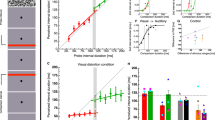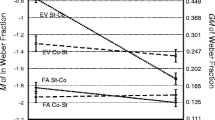Abstract
We examined the effect of temporal context on discrimination of intervals marked by auditory, visual and tactile stimuli. Subjects were asked to compare the duration of the interval immediately preceded by an irrelevant “distractor” stimulus with an interval with no distractor. For short interval durations, the presence of the distractor affected greatly the apparent duration of the test stimulus: short distractors caused the test interval to appear shorter and vice versa. For very short reference durations (≤100 ms), the contextual effects were large, changing perceived duration by up to a factor of two. The effect of distractors reduced steadily for longer reference durations, to zero effect for durations greater than 500 ms. We found similar results for intervals defined by visual flashes, auditory tones and brief finger vibrations, all falling to zero effect at 500 ms. Under appropriate conditions, there were strong cross-modal interactions, particularly from audition to vision. We also measured the Weber fractions for duration discrimination and showed that under the conditions of this experiment, Weber fractions decreased steadily with duration, following a square-root law, similarly for all three modalities. The magnitude of the effect of the distractors on apparent duration correlated well with Weber fraction, showing that when duration discrimination was relatively more precise, the context dependency was less. The results were well fit by a simple Bayesian model combining noisy estimates of duration with the action of a resonance-like mechanism that tended to regularize the sound sequence intervals.








Similar content being viewed by others
References
Arao H, Suetomi D, Nakajima Y (2000) Does time-shrinking take place in visual temporal patterns? Perception 29:819–830
Buhusi CV, Meck WH (2005) What makes us tick? Functional and neural mechanisms of interval timing. Nat Rev Neurosci 6:755–765
Buonomano DV (2000) Decoding temporal information: a model based on short-term synaptic plasticity. J Neurosci 20:1129–1141
Buonomano DV, Karmarkar UR (2002) How do we tell time? Neuroscientist 8:42–51
Buonomano DV, Merzenich MM (1995) Temporal information transformed into a spatial code by a neural network with realistic properties. Science 267:1028–1030
Burr D, Banks MS, Morrone MC (2009a) Auditory dominance over vision in the perception of interval duration. Exp Brain Res 198:49–57
Burr D, Silva O, Cicchini GM, Banks MS, Morrone MC (2009b) Temporal mechanisms of multimodal binding. Proc Biol Sci 276:1761–1769
Cicchini GM, Arrighi R, Cecchetti L, Giusti M, Burr DC (2012) Optimal encoding of interval timing in expert percussionists. J Neurosci 32:1056–1060. doi:10.1523/Jneurosci.3411-11.2012
Creelman CD (1962) Human discrimination of auditory duration. J Acoust Soc Am 34:582–593
Eagleman DM, Sejnowski TJ (2000) Motion integration and postdiction in visual awareness. Science 287:2036–2038
Ernst MO, Banks MS (2002) Humans integrate visual and haptic information in a statistically optimal fashion. Nature 415:429–433
Gibbon J (1977) Scalar expectancy theory and Weber’s Law in animal timing. Psychol Rev 84:279–325
Gibbon J, Malapani C, Dale CL, Gallistel C (1997) Toward a neurobiology of temporal cognition: advances and challenges. Curr Opin Neurobiol 7:170–184
Hellstrom A (1985) The time-order error and its relatives: mirrors of cognitive processes in comparing. Psychol Bull 97:35–61
Hollingworth HL (1910) The central tendency of judgements. J Philos Psychol Sci Methods 7:461–469
Ivry RB (1996) The representation of temporal information in perception and motor control. Curr Opin Neurobiol 6:851–857. doi:10.1016/S0959-4388(96)80037-7
Jazayeri M, Shadlen MN (2010) Temporal context calibrates interval timing. Nat Neurosci 13:1020–1026
Jones MR, McAuley JD (2005) Time judgments in global temporal contexts. Percept Psychophys 67:398–417
Karmarkar UR, Buonomano DV (2007) Timing in the absence of clocks: encoding time in neural network States. Neuron 53:427–438
Lewis PA, Miall RC (2009) The precision of temporal judgement: milliseconds, many minutes, and beyond. Philos Trans R Soc Lond B Biol Sci 364:1897–1905. doi:10.1098/rstb.2009.0020
Maass W, Natschlager T, Markram H (2002) Real-time computing without stable states: a new framework for neural computation based on perturbations. Neural Comput 14:2531–2560
McAuley JD, Jones MR (2003) Modeling effects of rhythmic context on perceived duration: a comparison of interval and entrainment approaches to short-interval timing. J Exp Psychol Hum Percept Perform 29:1102–1125. doi:10.1037/0096-1523.29.6.1102
Miyauchi R, Nakajima Y (2005) Bilateral assimilation of two neighboring empty time intervals. Music Percept 22:411–424
Monahan CB, Hirsh IJ (1990) Studies in auditory timing: 2. Rhythm patterns. Percept Psychophys 47:227–242
Nakajima Y, Ten Hoopen G, Van der Wilk R (1991) A new illusion of time perception. Music Percept 8:431–448
Nakajima Y, ten Hoopen G, Hilkhuysen G, Sasaki T (1992) Time-shrinking: a discontinuity in the perception of auditory temporal patterns. Percept Psychophys 51:504–507
Nakajima Y, ten Hoopen G, Sasaki T, Yamamoto K, Kadota M, Simons M, Suetomi D (2004) Time-shrinking: the process of unilateral temporal assimilation. Perception 33:1061–1079
Sawai K, Sato Y, Aihara K (2012) Auditory time-interval perception as causal inference on sound sources. Front Psychol 3:524. doi:10.3389/fpsyg.2012.00524
Spencer RM, Karmarkar U, Ivry RB (2009) Evaluating dedicated and intrinsic models of temporal encoding by varying context. Philos Trans R Soc Lond B Biol Sci 364:1853–1863. doi:10.1098/rstb.2009.0024
Treisman M (1963) Temporal discrimination and the indifference interval. Implications for a model of the “internal clock”. Psychol Monogr 77:1–31
Van Erp JBF, Spapé (2008) Time-shrinking and the design of tactons. In: Eurohaptics 08: proceedings of the 6th international conference on haptics: perception, devices and scenarios, pp 289–294
Watson AB, Pelli DG (1983) QUEST: a Bayesian adaptive psychometric method. Percept Psychophys 33:113–120
Acknowledgments
Supported by ERC grant 229445 “STANIB” and Italian Ministry of Universities and Research (PRIN2010).
Author information
Authors and Affiliations
Corresponding author
Rights and permissions
About this article
Cite this article
Burr, D., Rocca, E.D. & Morrone, M.C. Contextual effects in interval-duration judgements in vision, audition and touch. Exp Brain Res 230, 87–98 (2013). https://doi.org/10.1007/s00221-013-3632-z
Received:
Accepted:
Published:
Issue Date:
DOI: https://doi.org/10.1007/s00221-013-3632-z




